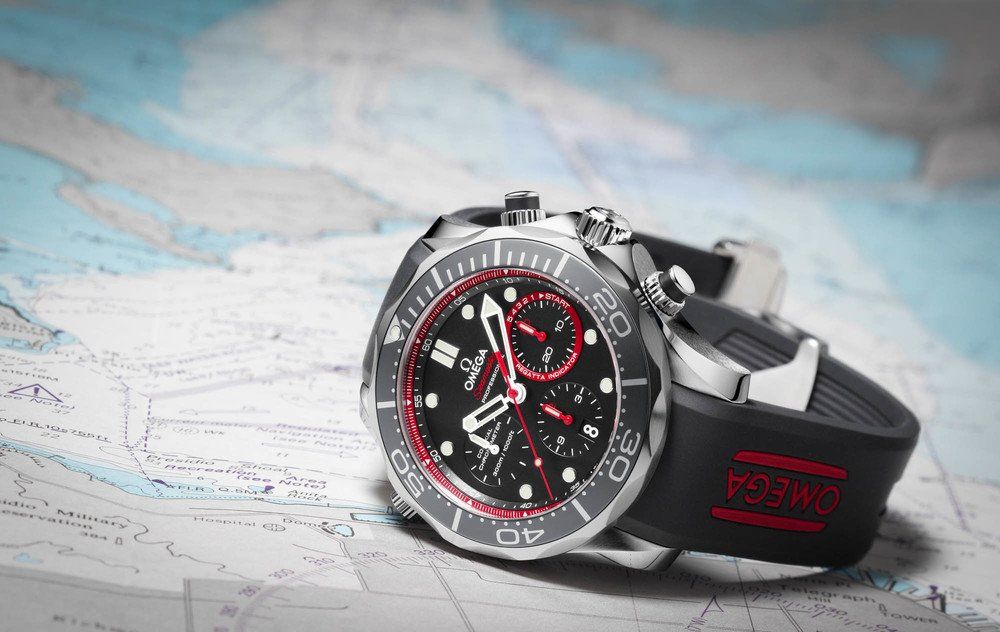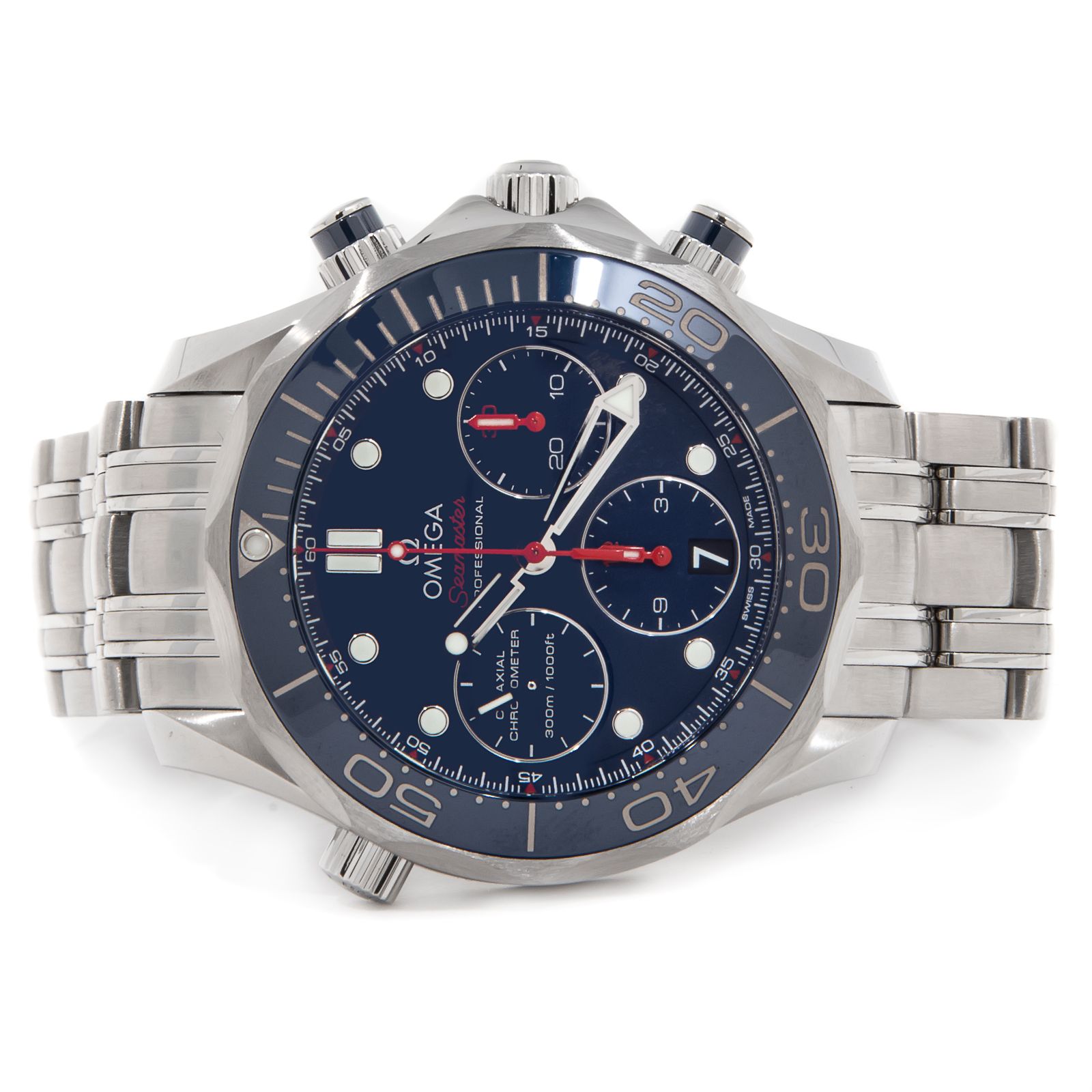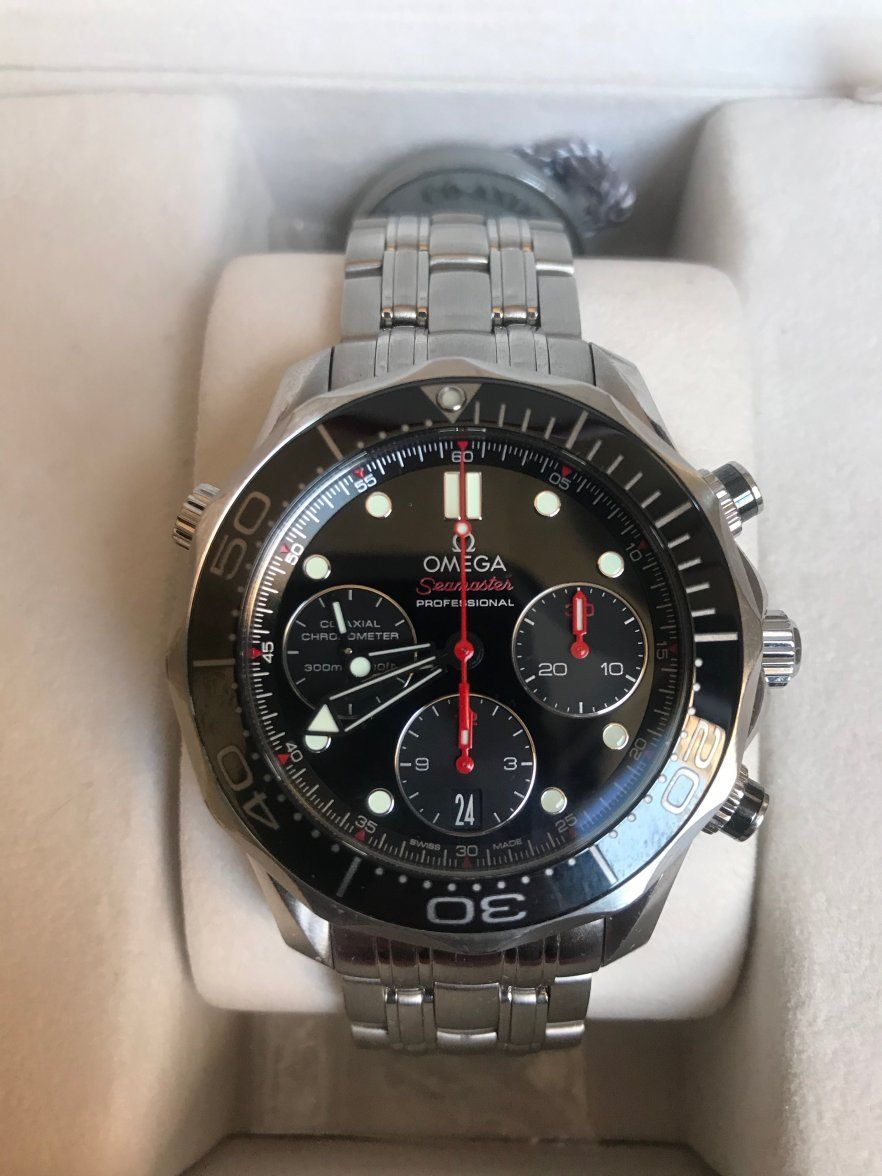As the third act in Omega’s famous Seamaster Pro 300M Chronograph line, this new ceramic model had enormous shoes to fill. Beyond that it had an important role, to restore some faith and avoid the controversy caused by the second generation.
A Strong Return to Form
The third generation Seamaster Pro Chronograph, powered by Co-Axial Calibre 3330 was released in 2013 alongside the Calibre 2500D Seamaster Pro Ceramic.
While the first generation was an enormous success and had been extremely popular, the second generation had gotten a bit lost, especially after being left to compete against its predecessor. Some teething issues with the second generation movement had also clouded the product, something the second generation three-hand Seamaster Pro models also suffered from.

For the third generation, Omega needed to create a watch that was a direct upgrade, and measurably better in every possible way. It had to be stronger, more durable, more accurate, more reliable, more comfortable, better finished, and better value than either of the generations that came before it.
As tall an order as this may sound, the resulting watch succeeded on all fronts and was an absolutely brilliant successor to one of Omega's second most important chronograph line after the Speedmaster Pro.
The Calibre 3330 Seamaster Pro Chrono Diver, like the Calibre 2500D Seamaster Pro is a perfect example of listening to feedback from customers, identifying what works and what doesn't and actively learning.

The overall formula hasn't changed a whole lot, you can see a great deal of the original 2599.80 design in this watch at a distance. When you get closer, the new pushers, borrowed from the Planet Ocean stand out, a great upgrade over the thin steel pushers of older models. The ceramic bezel and matching dial ensure no fading and no scratches, two problems owners had to deal with on past generations.
Two sizes were made available, the traditional 41.5 mm, and an extra-large 44 mm model for those with larger wrists seeking more of a presence.
Most importantly, when the third generation arrived in display cases alongside the 3-hand version, they did not compete with anything else. This was the future of the Seamaster Pro, Omega was completely confident in the product and there was no hedging of bets.
Case & Bracelet
The case and bracelet are both a continuation of the same winning formula created with the 2599.80 20 years earlier in 1993, and a key focus for innovation and improvement.
There is one drawback to mention from the start, as it may be a dealbreaker for some. The thickness of the 41.5 mm case is back up to 16.7 mm, similar to the first generation, while the extra-large 44 mm case is 17.3 mm thick. There is no getting around the fact that these are significant numbers and won't be for everyone. That said, Omega continues to do a masterful job of balancing a thick head out with superb bracelet and case design. The resulting product is a watch that feels stable and very comfortable on the wrist, even more so than the original.

The new Planet Ocean Chronograph style pushers are a significant departure from the previous smaller steel design. They feature the Planet Ocean's anodised aluminium barrels in the same color as the dial and bezel and maintain the full depth rating operable seals that the Seamaster Pro Chronographs are famous for. The key benefit ergonomically is that the much wider and flatter button should be far more comfortable and easier to use with cold, wet fingers. The smaller steel pushers of old could sometimes feel like they were stabbing into your fingers and required a bit more dexterity to operate.
The knurled crown has been enlarged compared to previous generations, and the crown-guards redesigned to make the crown more accessible, especially from the rear. This addresses another minor ergonomic shortcoming and makes winding, setting, and accessing the crown easier without putting it at greater risk of damage.

Finally, the ceramic bezel comes as a major benefit to owners over the aluminium bezel of old. The cost of replacing a full bezel assembly if the insert suffered fading or scratches was quite significant in the past and being painted it was quite difficult to maintain them in good shape.
With 10 years now of use in the field of both the chronograph and 3-hand versions of the Seamaster Pro in ceramic, these bezels have proven to be very strong and extremely resistant to damage. As mentioned in other articles, Omega has the benefit of being able to draw upon the immense talent of composite materials specialist Comadur SA from within Swatch Group to produce their ceramic bezels.
The final major change with this generation was the introduction of the 41.5 mm and 44 mm models in parallel. Aside from the diameter and thickness difference, these watches also have a different lug width and bracelet in order to preserve the overall proportions of the larger watch.

As a result, the 41.5 mm has 20 mm lugs while the 44 mm has 21 mm lugs with respectively sizes bracelets and straps. Both a steel Bond style bracelet is offered along with a modern rubber strap with deployant clasp.
The Bond bracelet itself has been updated with a simpler and shorter clasp bearing only the Omega logo in the center, still with a double push-button release and diver's extension. The new bracelet replaces the cumbersome pin and bushing system for sizing with a new system using screws and pins. Micro-adjustment is still don't with half-links as opposed to micro-adjust in the clasp.
Movement
The third generation of the Seamaster Pro 300M Divers Chronograph is powered by the Co-Axial Calibre 3330 movement.
The Calibre 3330 oscillates at 28,800 vph, features hacking, quick-set date, a column-wheel chronograph mechanism, and a traditional horizontal coupling yoke rather than a vertical clutch. It has a 52-hour power reserve from its single directional winding system.
The first thing to mention is that the Calibre 3330 has absolutely nothing in common with the Calibre 3301/3303 or other F. Piguet movements of the second generation at all. Many people frequently confuse these two because the numbers are so similar, but they have entirely different origins and family trees.

The Calibre 3330 is actually a heavily modified version of the Longines L688.2 chronograph, which in turn is based on a member of ETA's broader 7750 family of movements. This is very good news, because the 7750 family is excellent, accurate, dependable and durable. After the early issues with the 3301 / 3303 / 3313, Omega really didn't want to have any issues at all, and this base movement made for the best choice.
The key difference from the Longines L688.2 are the addition of the Co-Axial escapement, specifically the trouble-free 3-level version as used in the Calibre 2500D. The 3-level escapement is the original design George Daniels came up with and originally intended for production use, since the 2500D was introduced, all Omega movements that have followed continued to use this more robust design.
These watches can be serviced by any qualified independent watchmaker with access to an Omega parts account and after service you should expect quite excellent accuracy and performance. Having been around 10 years now, the Calibre 3330 has proven to be among the most trouble-free and well regarded chronographs on the market, as 7750 derived chronographs tend to be.
Variants
Omega greatly slimmed down and simplified the range with the third generation compared to earlier models. There are four categories, the regular 41.5 mm, the extra-large 44 mm, the extra-large 44 mm regatta watch, and the 44 mm titanium regatta watch.
Within the first three of those categories there are only two models to choose from. You don't get a great variety of metals, or any precious metals for that matter, there are no variations on bezel material, and color-ways are limited to the most popular.
That lack of variety does still leave a good range of choices, all of which look fantastic on the wrist.
Regular 41.5 mm
The regular model carries over many features from the original and second generation. The applied hour markers, the sword hands, the sub-dial layout and date position of the second generation all carry over.

The dial loses the wave pattern of previous models in favor of a gloss finish to match the bezel, and the applied Omega logo is also replaced with a more subtle and smaller logo. Additional text is moved to the seconds sub-dial, which is a convenient and sensible location, while legibility is enhanced by replacing the thin stick sub-dial hands with thicker luminous hands. The chronograph sub-dial hands are painted a matching red to the seconds hand to further simplify reading off elapsed time.
Lastly, the Seamaster is given alternating color lume, with blue used everywhere except for the bezel pearl and minutes hand which are green for maximum legibility.
These watches come in blue and black only, both with a black date wheel.


Extra-Large 44 mm
The extra-large size is a straight scaled up version of the regular model. As the movement is identical, the sub-dial layout and indeed most of the dial appears to be almost identical. Much of the added diameter comes from the actual case itself, the crown-guards, and the bezel.

It must be noted once again that the bracelet on the 44 mm models is 21 mm to fit the larger lugs and will only be compatible with similar sizes cases, while the case is also slightly thicker at 17.3 mm.
Like the regular version, the extra-large comes in only black and blue colors.


XL Regatta 44 mm
The 44 mm Seamaster Pro 300M Chronograph Regatta watches are based on the regular blue and black 44 mm versions with some subtle changes to make them more appropriate for sailing use.

Both watches only come in black dial and bezel, with a splash of red or yellow found in the sub-seconds outer track, the Seamaster logo, the chronograph hands, and the ring surrounding the minutes sub-dial. To make it more suitable for countdown use, the minutes sub-dial has 5, 4, 3, 2, 1 markings in descending order at the start of the sub-dial. While it adds a nice bit of flavor to the dials, it isn't overly practical and the numbers are not very legible.

The yellow model is a non-limited model and comes on bracelet only, while the red version is a limited edition of 2,013 units. The limited model comes in a set with both bracelet and the rubber strap shown below which has matching red trim and a spring-bar tool for changing them. The red ETNZ model also features a special case-back design featuring the Emirates Team New-Zealand logo.


XL Titanium Regatta 44 mm
The final third generation model, and the most unusual by far is the titanium ETNZ edition. This model, Ref 212.92.44.50.99.001, carries the same Emirates Team New Zealand case-back design as the red steel limited edition, but has quite a few differences beyond just the titanium case material to set it apart.

Firstly, this model only comes on a rubber strap, with no titanium bracelet available to match it. While some titanium models in the past have been able to borrow from other watches, the unusual shape of the 44 mm extra-large case will make that very difficult for this model.
The watch features a black ceramic bezel, with a white inner sub-seconds track, and a grey toned sandblasted grade-5 titanium metal dial. The watch features white hands for the time and red hands for the chronograph, with unusual-shaped hands on all sub-dials.

The minutes sub-dial is particularly unusual, with a triangular shaped hand offsetting allowing you to read the minutes either in count-down form from minutes 5-10 or in count-up form from 1-5. The advantage here is that even if the minute hand is partially obscuring this sub-dial hand, you will still be able to read one side of it accurately as it is wider than the main minute hand.
This is a very unusual design and a solution to a rather odd problem that might have been better solved with a design similar to the Seamaster APNEA or Regatta timer chronographs of old. It is something different and original though and I can't fault that.
The titanium regatta timer also features alternating red and black pusher barrels for start and stop, presumably to make these harder to mistake for one another.


Buying
Buying these Seamasters is a relatively straight forward set of questions, 41.5 mm or 44 mm, and then blue or black?
For most people, the 41.5 mm will be more than enough, and the benefits of having a more common 20 mm lug width and slightly less height make it worth buying over the larger version. The 44 mm models tend to be slightly more expensive as well as larger, and while the difference of 2.5 mm sounds significant, it isn't as much as you would expect on the wrist.

Both sizes tend to be equally plentiful as are the regatta models, even the limited edition and titanium models.
Typical prices as of early 2023 for the small versions range from $3,200-$4,000 on average while the larger versions are around $4,000-$4,700 so size does tend to matter in pricing.
Condition for these should always be pretty much perfect. The extensive use of ceramics makes these watches almost immune to scratches, fading and damage so any signs of this should be avoided. Minor scratches and desk diving marks are not a big deal, especially on the clasp which is an absolute magnet for marks and swirls. A watch that has been polished to the point of it being noticeable must be avoided, as should anything with deep scratches or gouges.

At this stage most of these watches are coming due for service fairly soon if not already, this should be factored into your purchase price and should be handled by a good independent in order to keep that cost under control.
For the Regatta watches, there is a very significant gap between the asking price of many listed by dealers or hopeful owners, and the actual price they tend to trade at. The black and yellow Ref 212.30.44.50.01.002 tends to be the cheapest, selling for $3,300-$4,000, while the red limited edition ETNZ ref 212.32.44.50.01.001 holds around $5,000-5,500. The titanium version on strap, ref 212.92.44.50.99.001 can be found for around $4,000-4,500.

The reason these numbers are lower than many would expect is that there are far more Omega regatta and sailing oriented watches out there in the market than there are people interested enough in sailing to specifically want them. Then there's also the fact that most mechanical regatta watches aren't very good for sailing compared to quartz digitals like the X-33 Regatta model as mentioned in the article below:

While not as varied and configurable as the range that came before it, the third generation of Seamaster Pro Chronograph is an excellent watch that improves in nearly every way from its predecessors. While now replaced by the much more expensive fourth generation, these Calibre 3330 watches sit in a sweet spot for price and performance, offering 95% of the benefits of the latest models for 30% of the price.
Discussion thread on Omegaforums can be found here:




